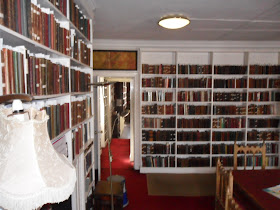Marcus Tullus Cicero (106-43 BC)
Notts Lit pays a visit to Nottingham's
only subscription library, celebrating its 200th birthday in 2016.
Sandwiched between a charity shop and a
newsagent’s is the entrance to the Grade II listed Bromley House. You may have
walked past it, heading up Angel Row on your way to Central Library or down to
the Bell Inn, unaware of the historic riches that await behind its front door.
 |
| Smith named the building Bromley House after his son changed his name to Bromley. |
Stepping inside the building is like walking through a wardrobe and discovering Narnia - at Christmas! You might find yourself looking back over your shoulder, to check you're really in the centre of Nottingham.
 |
The impressive entrance hall with its ornate decoration
|
The spacious hall - currently exhibiting a modern interpretation of the relationship between D.H. Lawrence and Louie Burrows - opens to an imposing stairway which provides a home for several older paintings. The stairs themselves are covered with a lead carpeting, laid down in 1844 and replaced in 1983.
 |
| Painting of the 1st Duke of Richmond |
A skylight illuminates the space and allows guests to appreciate the landing's 18th century design, with a gallery façade adorned with cherubs, shells and dogs.
Imposing double doors greet us on the first floor. Opposite them, a table of books, a sign that this is not a museum or stately home but a working library.
This is where the fiction is housed. Where a Marcel Proust can be found beneath a James Patterson. It's a bibliophile's paradise, but the sight and smell of books is only the half of it. There's a history here that's palpable. I expect to find Robert Langdon or Indian Jones searching for a secret code that will reveal the meaning of life. The great inventor Michael Faraday's name can be seen in an old visitor's book but this more a record of Nottingham's own intellectual heritage. One past member is the scientist and mathematician George Green, a father of quantum physics. He called Bromley House his first university. The library still attracts guests from the city's two Universities, as well as the British Sundial Society who peruse the shelves for information on modern sundial theory, scratch dials, stone circles and astronomy.
The room is brimming with original features, including shutters that are still closed every night as they would have been back in the mid 18th century.
While looking out over the garden you might notice a seat with the inscription 'for the use of twitchers’. The case contains binoculars, ideal for checking on the garden's wildlife.
 |
| The spiral staircase was added in 1857 |
An elegant spiral staircase leads up to a gallery filled with earlier fiction and ‘miscellanies’. During my visit, local school children were being guided - "one at a time please" - down the stairs, awe on their faces.
There are many books of interest to local historians, topographical works and a wide selection of 19th and early 20th-century novels. In recent years the collection's emphasis has been on biographies, travel books and new novels. New books are bought regularly and members' requests are considered for purchase.
Off the main library are several wonderful rooms, the finest of which is the Neville
Hoskins Reading Room, the town house's front room. The extravagant mouldings, such as found on the rococo style plaster
ceiling, ornate cornices and overmantels, were fashioned by highly talented craftsmen.
 |
| The painting over fireplace is by John Rawson Walker. He painted it to pay for his share in the library. The painting depicts the Nottingham poet and hymn writer Henry Kirk-White. |
At first glance the Standfast Library room looks like a coffee shop. People sat around in comfortable leather armchairs supping, whilst having a natter or browsing the many daily rags that are available for members to read. Then you notice the fine clocks, barometers, and, incredibly, a working meridian line. A small hole in the upper left of a window sends a beam of light along the brass strip on the floor at precisely true solar noon. It was used to set the clocks of Nottingham in days before standard time.
 |
| The George Green Room (named after the aforementioned mathematician of Green’s Mill) |
The room hosts regular meetings including a weekly gathering of volunteers who repair and restore old books.
On the top floor of the library is another special room; a studio that operated as the first photographic studio in Nottingham, from 1841 to 1955. A venue where many of Nottingham’s more wealthy 19th century families had their likenesses taken.
Nottingham’s first professional photographer, Alfred Barber, put in a skylight at his own expense, a circular and glass structure incorporating a cog wheel mechanism that could follow the passage of the sun. Some traces of his equipment can still be seen.
 |
| The library's theology section can now be found in the attic, containg a large collection of Victorian sermons. |
At the rear of the library
is a secret garden, a haven in the heart of the city.
The charm of the Georgian building is enhanced by the hidden Victorian garden with its tall trees, one of only two remaining town gardens in the city. It's a tranquil setting for members to use.
The theme of 'time' continues outdoors with a heliochronometer (a sophisticated sundial).
The library is accepting new members. Annual membership subscription is £80 and membership forms are available from the library by phone, email or in person. Two referees are required. Prospective members can attend one of their prospective members' events to get a flavour of the library and what membership offers.
email: enquiries@bromleyhouse.org
tel. 0115 9473134
Opening times and further information can be found on their website











Hidden Gutters Specialists in Surrey
ReplyDelete